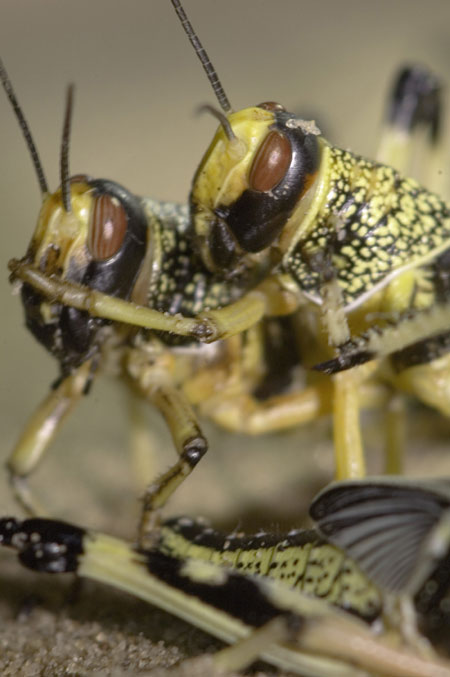Grasshoppers vs. Locusts: What Makes a Swarm?

Grasshoppers are in the news again. Or are they locusts?
Last week we learned locusts were swarming in Ethiopia, wiping out crops vital to the survival of local people.
Now we hear grasshoppers are invading Tooele County, Utah, near Salt Lake City. They're all over the ground, with people crunching them underfoot. The infestation is "worse than anyone can remember," AP reports.
What's the difference between the two bugs?
Green grasshoppers and brown locusts are close cousins, both in the grasshopper family. But while grasshoppers hop like mad and can be abundant and pesky, locusts can fly. More significant, locusts have the unusual ability to be total loners or to enter what scientists euphemistically call "a gregarious state" — this is the flying and swarming stage, the stuff of Biblical proportions.
Desert locusts affect 20 percent of the world's land surface, scientists say. Vast swarms containing billions of bugs periodically devastated parts of the United States back when the West was being settled. They continue to be a big problem in parts of Africa and China. Last November, swarms nearly 4 miles long (6 km) plagued Australia.
What makes them so, um, gregarious?
Sign up for the Live Science daily newsletter now
Get the world’s most fascinating discoveries delivered straight to your inbox.
An increase in the chemical serotonin (which boosts moods in humans) in certain parts of a locust's nervous system initiates the swarming behavior, according to a study published earlier this year in the journal Science.
It's nature's way of giving wing to a starved creature.
Desert locusts live in barren regions that see rain only rarely. They eke out an existence alone when times are tough. When the rains come, they breed like crazy. Then things dry up, and hoards of locusts are forced to gather around dwindling patches of vegetation.
"The gregarious phase is a strategy born of desperation and driven by hunger, and swarming is a response to find pastures new," said study team member Steve Rogers of Cambridge University.
Rogers and his colleagues found that in the lab, solitary locusts could be made gregarious within 2 hours simply by tickling their hind legs to simulate the jostling they experience in the wild. Serotonin levels spiked three-fold.
Once on the move, the epic swarms are all but inevitable. Here's how that works:
Scientists discovered a few years back that at low densities, the insects were unorganized and went their separate ways. But when the group's density increased, the bugs fell into an orderly line and began to follow the same direction.
Such "collective motion," which spells doom for a crop, is common also among ants, birds and fish.
The grasshoppers now invading Utah are born in cycles that run 7 to 10 years, scientists say, and the outbreak is nothing unusual for the natural world. What's really new is that there are more suburbanites to complain about them now.
In The Water Cooler, Imaginova's Editorial Director Robert Roy Britt looks at what people are talking about in the world of science and beyond. Find more in the archives and on Twitter.
Robert is an independent health and science journalist and writer based in Phoenix, Arizona. He is a former editor-in-chief of Live Science with over 20 years of experience as a reporter and editor. He has worked on websites such as Space.com and Tom's Guide, and is a contributor on Medium, covering how we age and how to optimize the mind and body through time. He has a journalism degree from Humboldt State University in California.











